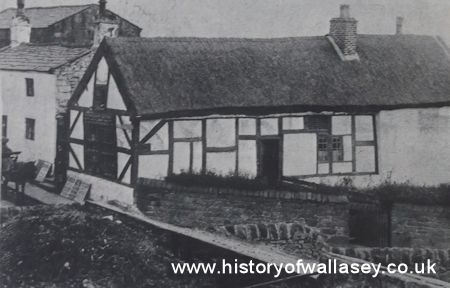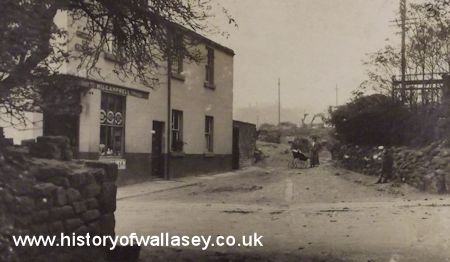Little shops served big families in the Wallasey of many years ago. Clanging doorbells, sawdust-covered floors, and everything weighed and wrapped by hand. At the turn of the last century the town was a place of small businesses. The chain stores had not arrived. The only ‘self-service’ was that indulged in by shoplifters.
There were the ‘cottage shops’ in the old days. Notices in the windows of houses advertised toffee apples, treacle slab, and home-made sweets.
The shops were open from 8 a.m. to 8 p.m. every day and from 8 a.m. to midnight on Saturdays.
The long hours met a public demand, for people worked until late at night. Goods would be delivered, by horse and cart, up to 11 p.m.
Butchers all wore striped aprons and straw hats. Bakers wore floury white.
The grocers had lots to weigh. Their goods came in bulk, and butter, sugar, lard and tea were carefully portioned out.
Most shops were illuminated by incandescence gas lighting. In bad weather it spluttered nosily, and gave a pungent smell.
The shopkeepers gave plenty of credit – they had to. Money was in short supply in big families.
A local saying went : “Living on the shopkeepers and the Board of Guardians”.
Milk shops got their supplies in churns. The milk was poured into jugs and basins.
In bakers shops bread was sold by weight. The sliced loaf, all ready wrapped, was a thing of the future.
 |
Sweets and newspapers were sold at the Cottage Store, Breck Road, and, as the notice said, hot water could be supplied to visitors |
The prices of years ago amaze. From old advertisements the following is a collection of some of them :-
In 1907, butter was 9d ib., sugar was 2d lb., and eggs were ½d each.
An ounce of tobacco was twopence. Small cigars could be had at a penny each.
At a ‘Penny Bazaar’, in Seacombe, the ‘6½d enamelware’ was declared ‘the best and, cheapest in the country’.
The old prices are as dead as the old practices – open windows, meat and fish laid open to dust and dirt, sales in the streets from little donkey carts.
There was little change in the shops of the town until the 1920s, when public health requirements became rather more stringent and various Shops Acts cut down the long opening hours.
It was in the 1920s the years of trundling tramcars and the first of the motor buses, that Liscard and Wallasey Village developed as shopping centres.
The old slabs and open windows began to disappear.
Bigger shops opened up. Moto vans rapidly replaced the horses and carts used for delivering orders.
In the 1920s and the 1930s local shops offered Danish bacon at 1s lb., Dee salmon at 3s lb., and legs and shoulders of lamb at half-a-crown each.
Made-to-measure suits were £3. Hemstitched pillowcases were 6d each.
In the middle of the 1930s unemployment – which had been serious in the area – began to drop. There was more money about, and the local shops were busier than ever.
 |
Mrs. Campbell's was one of the best-known small shops of the old town. 'Broadway, late Folly Lane', said the plate on the wall above it. |
The ‘free gifts’ gimmick came in. Coupons were collected in little books. There were give-aways with most purchases over £1 in grocers and greengrocers.
Cigarettes – with a card in every packet (‘Screen Favourites’, ‘Sports Stars’, and ‘Flags of the Nations’ were among the series) – were a shilling for 20.
Milk was 2d a pint. A large jar of jam was 8d. Gin, rum and whiskey averaged 12s a bottle.
Coal was delivered for 30s a ton. A dining room suite cost about £7.
Only a few weeks before the declaration of war in September, 1939, Wallasey shops were offering dinner ale at 6s for a dozen pint bottles, radio sets for £6, and bedroom suites for £18.
You could buy a pound of chocolates for 1s 2d. A 1 lb fruitcake was 9d.
Flour was 4d a 2 lb bag, cheese was 1s 3d lb, and pork sausages were 1s 4d lb.
The war changed all that. Prices, like everything else, were never to be the same again.
The 1940s brought more than blitzes and sirens and fires. They bought coupons and queues, rationing, and ‘war economy’ this, that and the other.
There were Personal Points and a meagre allowance of sweets once a week.
The black market was born. There were under-the-counter-dealings.
Ice-cream, oranges, bananas, - they were just memories. Cigarettes were for ‘regular customers only’.
The shops presented sad-looking shelves. Goods-wise, their cupboards were decidedly bare.
The 1940s were the years of scrimp and save and Spam – a processed meat that appeared on every family’s table.
Plenty, wide choice and low prices belonged to another world. “Don’t you know there’s a war on...”
There were Ministry of Food posters in all the shops. “Experiment with your meals,” they read.
They supplied recipes – almost always incorporating potatoes. “Spuds,” wrote a reader of the ‘Wallasey News’ in 1941, “would seem to have become the town’s main diet.”
Clutching their ration books, housewives queued up for a weekly four ounces of bacon, eight ounces of sugar, and two ounces each of butter, cheese, cooking fats and tea. Shops sold in ounces not pounds, Everything was in short supply.
The shortages went on into the immediate post-war years. Then the shops stocked up again.
By the 1960s new stores arrived, Big and modern and super-efficient. Almost everything ready-wrapped, deep-frozen, pre-weighed.
Never again the old sawdust floors, the spluttering gaslights, the horse and cart deliveries, or the open window displays.
Butter at 9d a lb was just a memory – like tobacco at 2d, eggs at ½d each, and warm white bread a couple of coppers a crusty cob.
Few of the little corner shops remain. The big chain store like ASDA and TESCO have moved in. Gone where assistants cut cheese with a wire on the counter, where the doorbell clanged, and where the mixture of scents – from soap to apples – was a poem on the nose.
Featured sites
- Non Gamstop Casinos
- Casino Not On Gamstop
- UK Casinos Not On Gamstop
- Non Gamstop Casinos UK
- Sites Not On Gamstop
- Sites Not On Gamstop
- Casinos Not On Gamstop
- Casinos Not On Gamstop
- Casinos Not On Gamstop
- Non Gamstop Casino UK
- Casinos Not On Gamstop
- Non Gamstop Casino
- UK Online Casinos Not On Gamstop
- UK Online Casinos Not On Gamstop
- Non Gamstop Casinos
- Casino Sites Not On Gamstop
- Casinos Not On Gamstop
- Casinos Not On Gamstop
- Best Betting Sites
- Casinos Not On Gamstop
- Gambling Sites Not On Gamstop
- Betting Sites That Are Not On Gamstop
- Non Gamstop Casinos UK
- UK Online Casinos Not On Gamstop